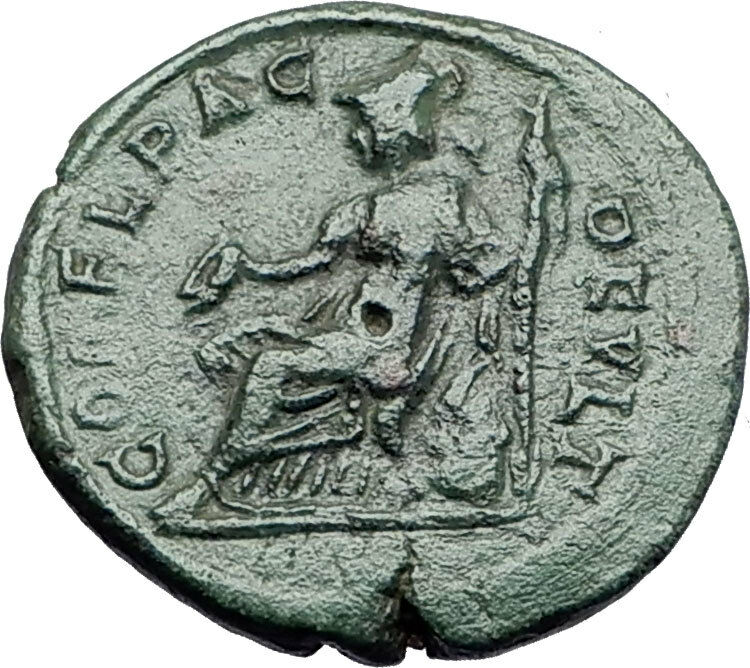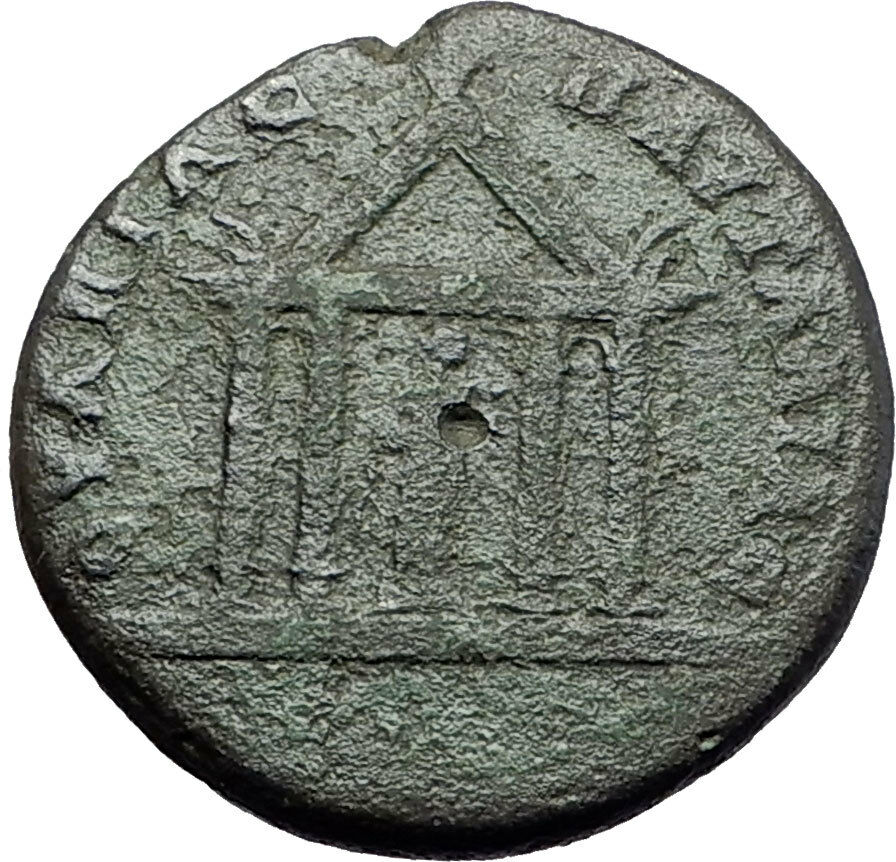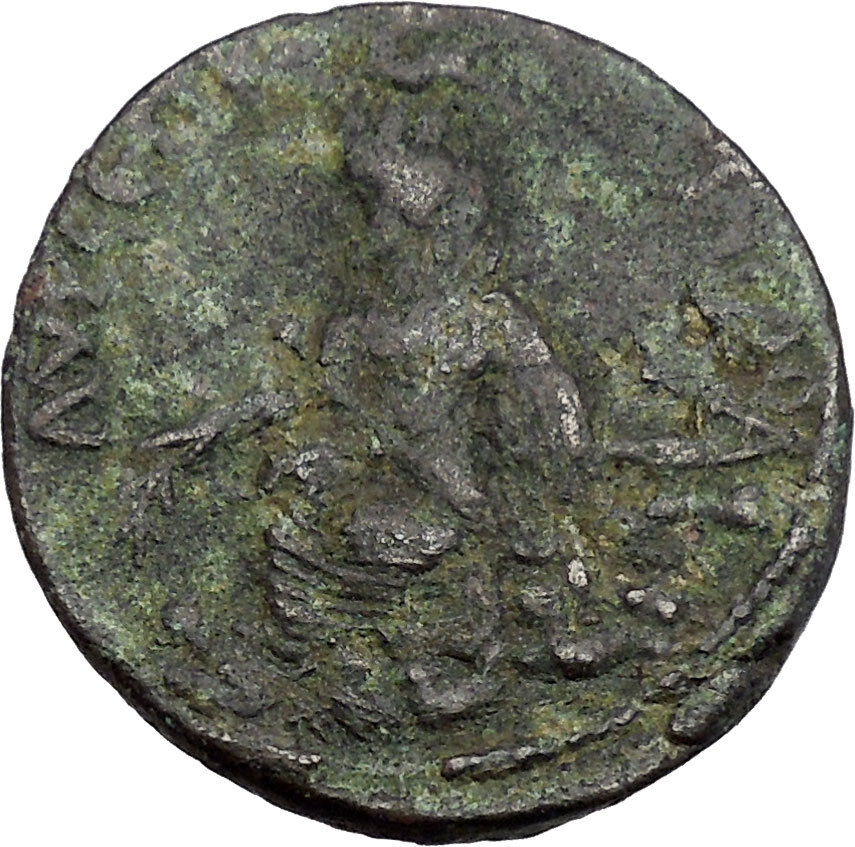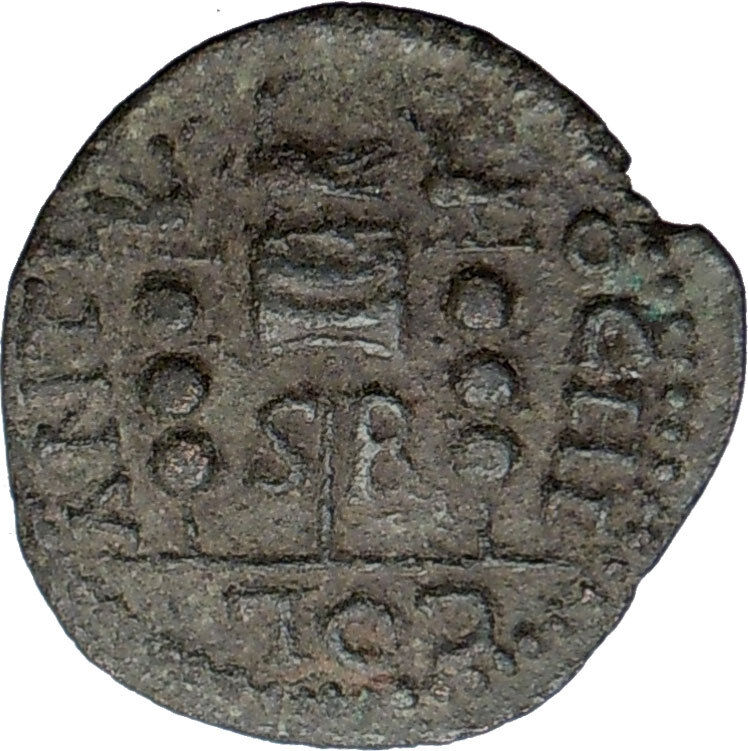|
Gordian III – Roman Emperor: 238-244 A.D. –
Bronze 26mm (10.66 grams)
from the city Nicopolis ad Istrum in Moesia Inferior under magistrate Modestus
AVT K M ANT ΓOPΔIANOC AVΓ, laureate, draped bust right.
VΠ CAB MOΔECTOV NIKOΠOΛЄITΩN ΠPOC ICTPO, Hygeia standing right, feeding serpent
from patera.
You are bidding on the exact
item pictured, provided with a Certificate of Authenticity and Lifetime
Guarantee of Authenticity.
In
Greek
and
Roman mythology
, Hygieia (also Hygiea
or Hygeia, Greek Ὑγιεία or
Ὑγεία, Latin Hygēa or Hygīa),
was the daughter of the god of medicine,
Asclepius
, and
Epione
. She was the goddess/personification of
health, cleanliness and sanitation.
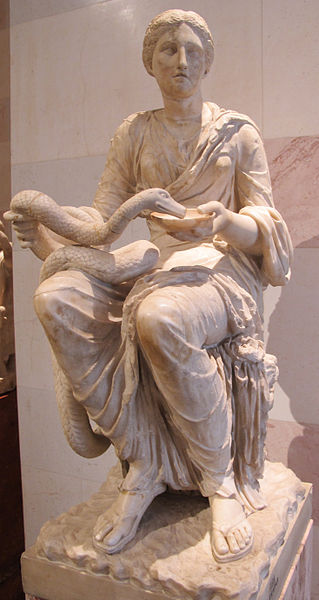
Hygieia
and her five sisters each performed a facet of
Apollo
‘s art: Hygieia (“Hygiene” the
goddess/personification of health, cleanliness, and sanitation),
Panacea
(the goddess of Universal remedy),
Iaso (the goddess of recuperation from illness),
Aceso
(the goddess of the healing process).
Hygieia also played an important part in her father’s
cult
. While her father was more directly
associated with healing, she was associated with the prevention of sickness and
the continuation of good health. Her name is the source of the word “hygiene“.
She was imported by the Romans as the Goddess Valetudo, the goddess of personal
health, but in time she started to be increasingly identified with the ancient
Italian goddess of social welfare,
Salus
.
History
At Athens, Hygieia was the subject of a local cult since at least the 7th
century BC. “Athena Hygieia” was one of the cult titles given to
Athenaa
, as Plutarch recounts of the building of
the Parthenon
(447-432 BC):
|
“ |
A strange accident happened in the course of building, which showed that
the goddess was not averse to the work, but was aiding and co-operating
to bring it to perfection. One of the artificers, the quickest and the
handiest workman among them all, with a slip of his foot fell down from
a great height, and lay in a miserable condition, the physicians having
no hope of his recovery. When Pericles was in distress about this, the
goddess [Athena] appeared to him at night in a dream, and ordered a
course of treatment, which he applied, and in a short time and with
great ease cured the man. And upon this occasion it was that he set up a
brass statue of Athena Hygieia, in the citadel near the altar, which
they say was there before. But it was
Phidias
who wrought the goddess’s image
in gold, and he has his name inscribed on the pedestal as the workman of
it. |
” |
However, the cult of Hygieia as an independent goddess did not begin to
spread out until the
Delphic oracle
recognized her, and after the
devastating
Plague of Athens
(430-427 BC) and in Rome in
293 BC.
In the 2nd century AD,
Pausanias
noted the statues both of Hygieia and
of Athena Hygieia near the entrance to the
Acropolis
of Athens.
Worship
Hygieia’s primary temples were in
Epidaurus
,
Corinth
,
Cos
and Pergamon
.
Pausanias
remarked that, at the Asclepieion
of Titane
in
Sicyon
(founded by
Alexanor
, Asclepius’ grandson), statues of
Hygieia were covered by women’s hair and pieces of
Babylonian
clothes. According to inscriptions,
the same sacrifices were offered at
Paros
.
Ariphron
, a Sicyonian artist from the 4th
century BC wrote a well-known
hymn celebrating her. Statues of Hygieia were created by
Scopas
,
Bryaxis
and
Timotheus
, among others, but there is no clear
description of what they looked like. She was often depicted as a young woman
feeding a large snake that was wrapped around her body or drinking from a jar
that she carried. These attributes were later adopted by the
Gallo-Roman
healing goddess,
Sirona
. Hygieia was accompanied by her brother,
Telesphorus
.
In
Greekek
and
Roman mythology
, Hygieia,
or Hygeia, was a daughter
of the god of medicine,
Asclepius
.
She was the goddess of health, cleanliness and sanitation and afterwards, the
moon. She also played an important part in her father’s
cult
. While her father was more directly associated with healing, she was associated with healing, she was
associated with the prevention of sickness and the continuation of good health.
Her name is the source of the word “hygiene“.
//
At Athens, Hygieia was the subject of a local cult since at least the
7th
century BC
. “Athena Hygieia” was one of the cult titles given to
Athena
, as
Plutarch recounts of the building of the
Parthenon
(447-432 BC):
However, the cult of Hygieia as an independent goddess did not begin to
spread out until the
Delphic oracle
recognized her, and after the devastating
Plague of Athens
(430-27 BC) and in Rome in 293 BC.
In the second century AD,
Pausanias
noted the statues both of Hygieia and of Athena Hygieia near the
entrance to the
Acropolis
of Athens.
Hygieia’s primary temples were in
Epidaurus
,
Corinth
, Cos
and
Pergamon
.
Pausanias
remarked that, at the Asclepieion of
Titane
in
Sicyon
(founded
by Alexanor
,
Asclepius’ grandson), statues of Hygieia were covered by women’s hair and pieces
of Babylonian
clothes. According to inscriptions, the same sacrifices were offered at
Paros
.
Ariphron
,
a Sicyonian artist from the
4th
century BC
wrote a well-known
hymn celebrating
her. Statues of Hygieia were created by
Scopas
,
Bryaxis
and
Timotheus
,
among others, but there is no clear description of what they looked like. She
was often depicted as a young woman feeding a large snake that was wrapped
around her body or drinking from a jar that she carried.
These attributes were later adopted by the
Gallo-Roman
healing goddess,
Sirona
. Hygieia
was accompanied by her brother,
Telesphorus
.
“Hygieia” was used as a greeting among the
Pythagoreans
.
Nicopolis ad Istrum was a
Roman
and Early
Byzantine
town founded by Emperor
Trajan
around
101–106, at the junction of the Iatrus (Yantra)
and the Rositsa
rivers, in memory of his victory over the
Dacians
. Its
ruins are located at the village of
Nikyup
, 20 km north of
Veliko Tarnovo
in northern
Bulgaria
.
The town reached its apogee during the reigns of Trajan,
Hadrian
, the
Antonines
and the
Severan dynasty
.
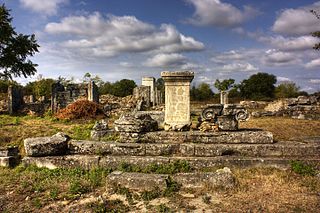
The classical town was planned according to the orthogonal system. The
network of streets, the forum surrounded by an Ionic colonnade and many
buildings, a two-nave room later turned into a basilica and other public
buildings have been uncovered. The rich architectures and sculptures show a
similarity with those of the ancient towns in Asia Minor. Nicopolis ad Istrum
had issued coins, bearing images of its own public buildings.
In
447 AD
, the town was destroyed by
Attila’s
Huns
.
Perhaps it was already abandoned before the early 400s.
In the 6th century, it was rebuilt as a powerful fortress enclosing little more
than military buildings and churches, following a very common trend for the
cities of that century in the Danube area.The largest area of the extensive ruins (21.55 hectares) of the classical
Nicopolis was not reoccupied since the fort covered only one fourth of it (5.75
hectares), in the southeastern corner.
The town became an episcopal centre during the early Byzantine period. It was
finally destroyed by the Avar invasions at the end of the 6th century. A
Bulgarian medieval settlement arose upon its ruins later (10th-14th century).
Nicopolis ad Istrum can be said to have been the birthplace of
Germanic
literary tradition. In the 4th century, the
Gothic
bishop,
missionary and translator
Ulfilas
(Wulfila)
obtained permission from Emperor
Constantius II
to immigrate with his flock of converts to Moesia and settle
near Nicopolis ad Istrum in 347-8.
There, he invented the
Gothic alphabet
and translated the
Bible
from
Greek
to
Gothic
.
Marcus Antonius Gordianus Pius (January
20, 225
–
February
11
, 244
),
known in
English
as Gordian III,
 was was
Roman
Emperor
from 238 to 244. Gordian was the son of
Antonia Gordiana
and his father was an unnamed Roman Senator who died before
238. Antonia Gordiana was the daughter of Emperor
Gordian I
and younger sister of Emperor
Gordian II
.
Very little is known on his early life before becoming Roman Emperor. Gordian
had assumed the name of his maternal grandfather in 238.
Following the murder of emperor
Alexander Severus
in Moguntiacum (modern
Mainz
), the
capital of the
Roman province
Germania Inferior
,
Maximinus Thrax
was acclaimed emperor, despite strong opposition of the
Roman senate
and the majority of the population. In response to what was
considered in Rome as a rebellion, Gordian’s grandfather and uncle, Gordian I
and II, were proclaimed joint emperors in the
Africa Province
. Their revolt was suppressed within a month by Cappellianus,
governor of Numidia
and a loyal supporter of Maximinus Thrax. The elder Gordians died,
but public opinion cherished their memory as peace loving and literate men,
victims of Maximinus’ oppression.
Meanwhile, Maximinus was on the verge of marching on Rome and
the Senate elected
Pupienus
and Balbinus
as joint emperors. These senators were not popular men and the population of
Rome was still shocked by the elder Gordian’s fate, so that the Senate decided
to take the teenager Gordian, rename him Marcus Antonius Gordianus as his
grandfather, and raise him to the rank of
Caesar
and imperial heir.
Pupienus
and Balbinus
defeated Maximinus, mainly due to the defection of several
legions
,
namely the
Parthica II
who assassinated Maximinus. But their joint reign was
doomed from the start with popular riots, military discontent and even an
enormous fire that consumed Rome in June 238. On
July 29
,
Pupienus and Balbinus were killed by the
Praetorian guard
and Gordian proclaimed sole emperor.
Rule
Due to Gordian’s age, the imperial government was surrendered
to the aristocratic families, who controlled the affairs of Rome through the
senate. In 240,
Sabinianus
revolted in the African province, but the situation was dealt quickly. In 241,
Gordian was married to Furia Sabinia
Tranquillina
, daughter of the newly appointed praetorian prefect,
Timesitheus
. As chief of the Praetorian guard and father in law of the
emperor, Timesitheus quickly became the de facto ruler of the Roman
empire.
In the 3rd century, the Roman frontiers weakened against the
Germanic tribes across the
Rhine
and
Danube
, and the
Sassanid
kingdom across the
Euphrates
increased its own attacks. When the Persians under
Shapur I
invaded Mesopotamia
, the young emperor opened the doors of the
Temple of Janus
for the last time in Roman history, and sent a huge army to
the East. The Sassanids were driven back over the Euphrates and defeated in the
Battle of Resaena
(243). The campaign was a success and Gordian, who had
joined the army, was planning an invasion of the enemy’s territory, when his
father-in-law died in unclear circumstances. Without Timesitheus, the campaign,
and the emperor’s security, were at risk.
Marcus Julius Philippus, also known as
Philip the Arab
, stepped in at this moment as the new Praetorian Prefect and
the campaign proceeded. In the beginning of 244, the Persians counter-attacked.
Persian sources claim that a battle was fought (Battle
of Misiche) near modern
Fallujah
(Iraq)
and resulted in a major Roman defeat and the death of Gordian III[1].
Roman sources do not mention this battle and suggest that Gordian died far away,
upstream of the Euphrates. Although ancient sources often described Philip, who
succeeded Gordian as emperor, as having murdered Gordian at Zaitha (Qalat es
Salihiyah), the cause of Gordian’s death is unknown.
Gordian’s youth and good nature, along with the deaths of his
grandfather and uncle and his own tragic fate at the hands of another usurper,
granted him the everlasting esteem of the Romans. Despite the opposition of the
new emperor, Gordian was deified by the Senate after his death, in order to
appease the population and avoid riots.
Securitas – Security, as a goddess worshipped by the Romans, is delineated in
a great variety of ways on their imperial coins. She appears for the most part
under the form of a woman in matronly costume; though in some few instances she
is but half clothed, having a veil thrown over the lower extremities. Sometimes
she is quietly seated, as if perfectly at her ease and having nothing to fear.
That is to say, her right or her left elbow rests on her chair, and the hand
supports her head, as in Nero. Or else one of her arms is placed above the head;
an attitude which ancient artists regarded as characteristic of repose. She
holds in one or other of her hands either a sceptre, or a scipio, or the hasta
pura, or a cornucopia, or a patera, or a globe. On some medals there is near her
a lighted altar; on others she stands leaning against, or with her arm upon, a
column or cippus, having sometimes the legs crossed in a tranquil, easy posture,
carrying one of the above-mentioned symbols, or otherwise holding before her a
branch or a crown of olive, or a palm branch. The meaning of these various
attitudes and attributes is on the whole too evident to require explanation.
There are medals of nearly all the emperors (with flagrant inappropriateness to
most of the reigns) from Otho and Vitellius to Constans and Constantius jun.,
which have for the type of their reverses this figure of Security, and present
for their legend the word SECVRITAS, with the addition of the words, AVGVSTI, or
AVGVSTORVM (security of the emperor or of the emperors); ORBIS (security of the
world) ; PVBLICA (public security) ; PERPETVA (perpetual security) ; POPVLI
ROMANI (security of the Roman people) TEMPORVM (of the Times) ; IMPERII (of the
empire) SAECVLI (of the age) ; REPVBLICAE (of the republic), etc.
|






 associated with healing, she was
associated with healing, she was 
 was
was